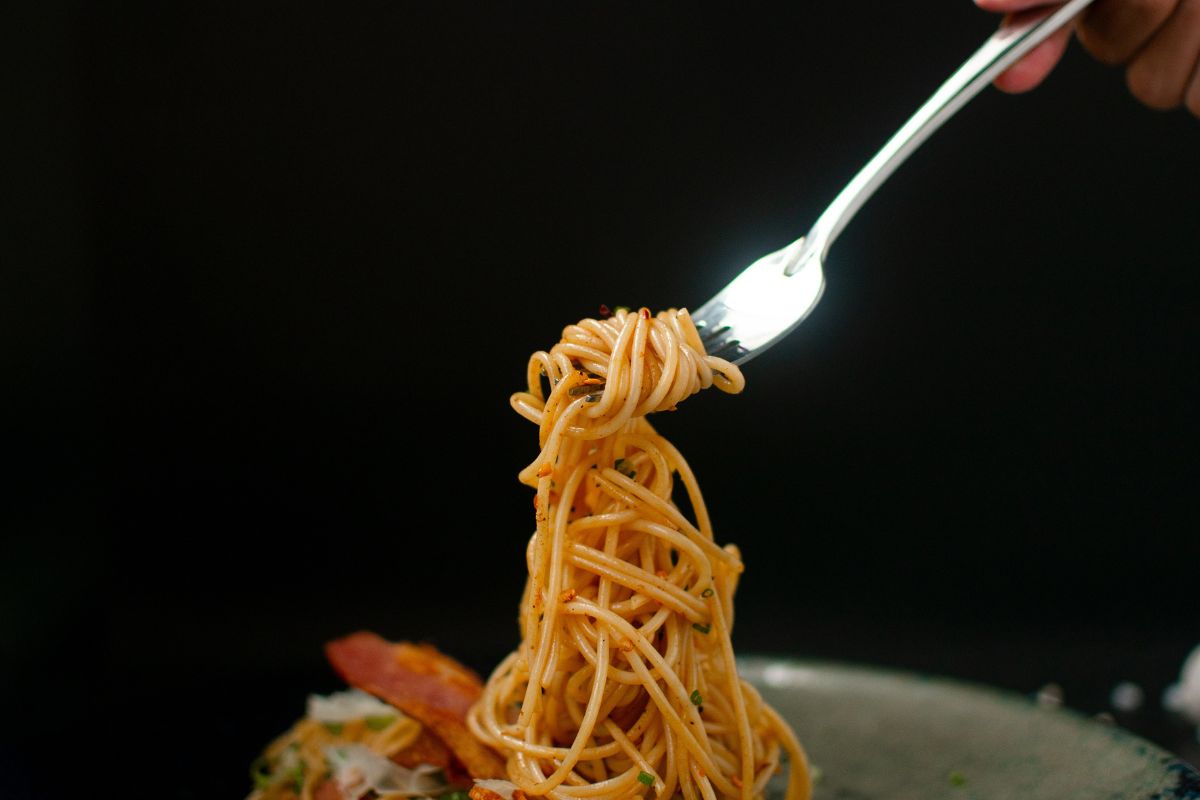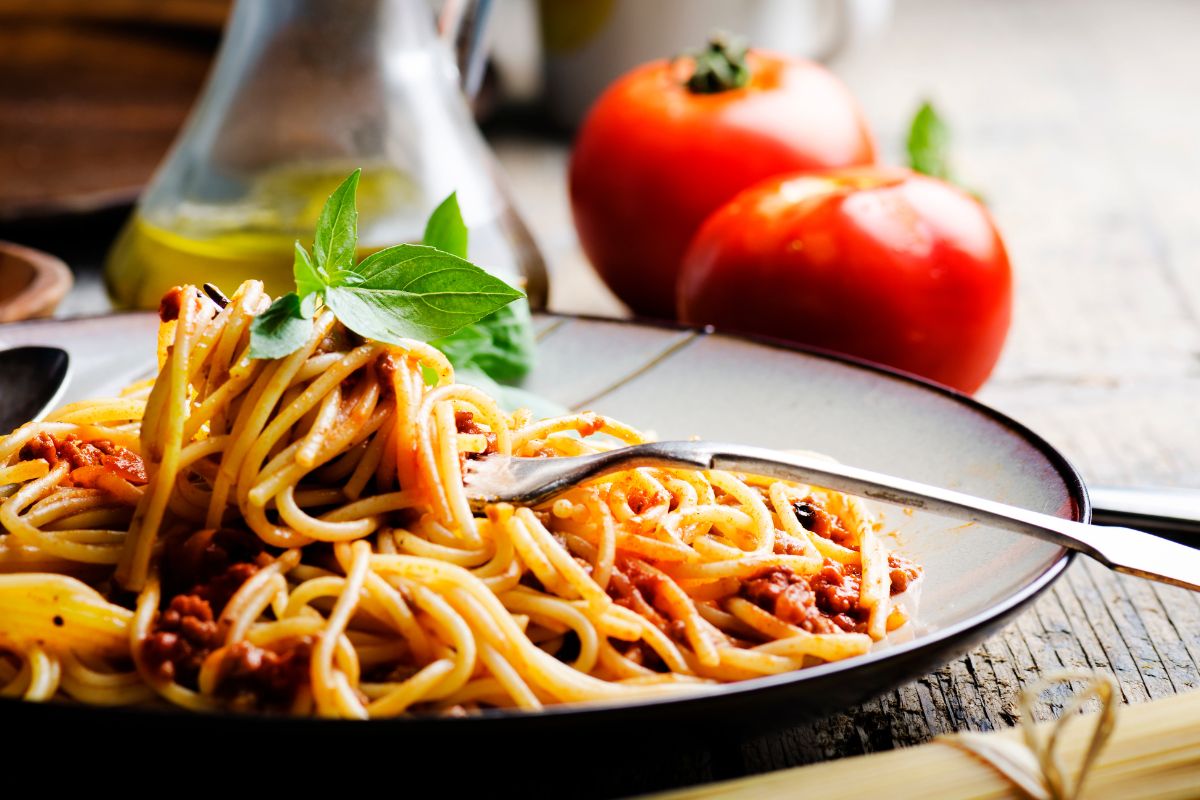Is Spaghetti Good After Four Days?
You may wonder, how long is spaghetti good for in the fridge, and is spaghetti good after four days? The safety and freshness of spaghetti after four days depends on storage and conditions.
Cooked spaghetti can be safe for up to four days if stored properly.
Use an airtight container or sealed plastic bag to prevent moisture and bacteria. Refrigerate at or below 40°F (4°C) to slow bacterial growth.

How Long is Spaghetti Good for in the Fridge?
Spaghetti can remain good for up to three to five days when stored correctly in the refrigerator. Keeping the spaghetti in a sealed plastic bag is essential to maintain its freshness and prevent moisture and bacteria from entering.
However, before consuming it, it is good to use your judgment and inspect the spaghetti for any signs of spoilage, such as an off odor, mold growth, or significant changes in texture or color. If you have any doubts, it’s safer to discard it.
Why Should Cooked Spaghetti be Refrigerated?
You should refrigerate cooked spaghetti for several reasons:
- Food safety: Refrigeration helps inhibit the growth of bacteria, including harmful pathogens, that can cause foodborne illnesses. Storing cooked pasta in the fridge
creates an environment that slows down bacterial growth and reduces the risk of food poisoning.
- Preservation: Refrigeration helps maintain the freshness and quality of cooked spaghetti. The cool temperature slows down enzymatic reactions that can cause the pasta to spoil more quickly. It also helps preserve the texture and flavor of the spaghetti, allowing it to remain enjoyable for a longer period.
- Moisture control: Storing spaghetti in the refrigerator helps control moisture levels. An airtight container or sealed plastic bag prevents the absorption of excess moisture, which can lead to a soggy or mushy texture. It also helps prevent the growth of mold and fungi.
- Extended shelf life: Refrigeration extends the shelf life of cooked spaghetti. By keeping it at a low temperature, you can safely consume it for a few days after cooking, reducing waste and allowing for convenient meal planning and leftovers.
Remember to refrigerate the spaghetti promptly after it cools down to minimize bacterial growth and maintain its quality.
How Long is Spaghetti Sauce Good for in the Fridge?
You may be asking, how long is prego spaghetti sauce good for in the fridge? When stored properly in the refrigerator, homemade or store-bought spaghetti sauce can remain good for three to five days.
If you are unsure about the quality or safety of the spaghetti sauce, it is advisable to err on the side of caution and discard it. It’s always better to prioritize food safety and avoid consuming spoiled or potentially harmful food.
How Long is Spaghetti and Meatballs Good for in the Fridge?
Regarding spaghetti and meatballs, the shelf life in the fridge depends on the components involved. If you cooked and sauced the spaghetti, it could typically remain good for about three to five days in the refrigerator when stored properly.
On the other hand, if you cook and put the meatballs in the sauce, they can also last for about three to five days in the fridge. Ensure you store it in an airtight container or submerged in the sauce to maintain quality.
When combining spaghetti and meatballs, it’s best to consider the shorter shelf life of either component. If you cooked and sauced the spaghetti and meatballs together, follow the shorter time frame of three to five days for storage in the fridge.
How Long Is Spaghetti Squash Good For In The Fridge?
Regarding spaghetti squash, its shelf life in the fridge is generally longer than cooked spaghetti or meatballs. If the spaghetti squash is whole, it can last several weeks to a few months when stored properly in the fridge.
However, if the squash is already in halves or portions, it can typically remain good for about five to seven days when stored in an airtight container or wrapped tightly in plastic wrap. This helps maintain its freshness and prevent drying out.
Remember, these timeframes are general guidelines, and the actual shelf life can vary depending on factors like the freshness of the squash when purchased and the storage conditions. It’s always advisable to use your judgment and prioritize food safety when determining the suitability of spaghetti squash for consumption.
How to Know If Spaghetti Has Gone Bad
To determine if spaghetti has gone bad, look out for the following signs:
- Visual changes: Inspect the spaghetti for any visible signs of spoilage. Check for mold growth, discoloration, or the presence of dark spots. If you notice any unusual or off-putting appearance, it may indicate that the spaghetti has gone off.
- Foul odor: Take a sniff of the spaghetti. It is likely spoiled if it emits a strong, unpleasant, or sour odor. Fresh spaghetti should not have a rancid or off odor. Trust your sense of smell to detect any signs of spoilage.
- Texture changes: Cooked spaghetti that has gone bad might exhibit changes in texture. It may become excessively mushy, slimy, or sticky. If the texture feels significantly different from when it was fresh, it can indicate spoilage.
- Taste test: If the spaghetti passes the visual, odor, and texture checks, you can cautiously taste a small portion. If the flavor is off, has a sour taste, or tastes unpleasant, it clearly indicates that the spaghetti has gone bad.
It is crucial to note that consuming spoiled food can lead to foodborne illnesses. If you have any doubts about the freshness or safety of the spaghetti, it is best to discard it to avoid potential health risks.

How to Store Spaghetti in the Fridge
To properly store spaghetti in the fridge, follow these steps:
- Cool down the spaghetti: Allow the cooked spaghetti to cool down to room temperature before refrigerating. This prevents condensation and helps maintain its texture.
- Use airtight containers: Transfer the spaghetti to airtight containers or sealable plastic bags. Ensure the containers are clean and dry to prevent contamination and maintain freshness.
- Portion control: If you have a large batch of spaghetti, consider dividing it into smaller portions. This allows you to take out only what you need, minimizing waste and preserving the quality of the remaining spaghetti.
- Label and date: Label the containers or bags with the storage date. This helps you track how long the spaghetti has been in the fridge and ensures you use it within a safe time frame.
- Refrigerate promptly: Place the airtight containers or bags of spaghetti in the refrigerator as soon as possible. Store them on a shelf rather than the refrigerator door for more consistent temperatures.
- Maintain proper temperature: Set your refrigerator below 40°F (4°C). This helps slow down bacterial growth and keeps the spaghetti fresh longer.
Tips for Reheating Refrigerated Spaghetti
Here are some tips for reheating refrigerated spaghetti:
Stovetop Method
Reheating spaghetti on the stovetop is a popular option. Place the refrigerated spaghetti in a saucepan or skillet and add a small amount of water or additional sauce to prevent it from drying. Heat it over medium-low heat. Ensure the spaghetti heats thoroughly.
Microwave Method
You can reheat spaghetti in the microwave if you prefer a quick and convenient option. Transfer a portion of the refrigerated spaghetti to a microwave-safe dish and cover it, leaving a small vent for steam to escape. Heat it in short intervals, stirring occasionally, until the spaghetti heats properly.
Oven Method
For larger quantities of spaghetti, reheating in the oven is an effective option. Preheat the oven to around 350°F (175°C). Place the spaghetti in an oven-safe dish and cover it with aluminum foil to prevent excessive drying. Heat it in the oven for approximately 20-30 minutes or until thoroughly heated.
Proper Heating
Regardless of your chosen method, ensure to heat the spaghetti thoroughly to an internal temperature of at least 165°F (74°C) to kill any potential bacteria. Stirring during heating helps distribute the heat evenly and ensures uniform reheating.
Sauce and Moisture
If the reheated spaghetti appears dry, add a little extra sauce or a splash of water to restore moisture and prevent it from becoming too dry.
Final Check
Before consuming, take a moment to ensure that the spaghetti heats throughout. You can use a food thermometer to check the internal temperature if needed. Following these tips, you can successfully reheat refrigerated spaghetti while ensuring it is thoroughly heated and enjoyable.
What Happens if You Eat Bad Spaghetti?
Eating bad spaghetti can lead to various health issues. Food spoils can contain harmful bacteria, such as Salmonella, E. coli, or Staphylococcus aureus, which can cause foodborne illnesses.
If you consume bad spaghetti, you may experience nausea, vomiting, stomach cramps, diarrhea, and sometimes, fever. The severity and duration of these symptoms can vary depending on the specific bacteria involved and individual factors.
In more severe cases, consuming spoiled food can lead to food poisoning, dehydration, electrolyte imbalances, and other complications. Certain bacteria may also produce toxins that can cause additional symptoms and complications.
It’s important to note that the symptoms of foodborne illnesses can range from mild to severe and can be particularly dangerous for individuals with weakened immune systems, young children, and pregnant women.
It is best to seek medical attention if you suspect you ate bad spaghetti and experience persistent or severe symptoms. It’s always better to prioritize food safety, discard any food you suspect has gone bad, and practice proper food handling and storage to reduce the risk of consuming spoiled or contaminated food.
Recipe Ideas for Leftover Spaghetti
Here are some recipe ideas for leftover spaghetti:
- Spaghetti Frittata
- Spaghetti Pizza Crust
- Spaghetti Salad
- Spaghetti Casserole
- Spaghetti Stir-Fry
- Spaghetti Bolognese Stuffed Peppers
- Spaghetti Carbonara
- Spaghetti And Meatball Subs
- Spaghetti Pie
- Spaghetti Primavera
These recipes provide different ways to repurpose leftover spaghetti into new and delicious meals.

A Final Word
In conclusion, cooked spaghetti can typically remain fresh in the fridge for about three to five days when stored properly. By following essential guidelines such as using airtight containers, refrigerating at the required temperature, and inspecting for signs of spoilage, you can maximize the shelf life of pasta and ensure its safety.
However, it is essential to use your judgment and discard the spaghetti if you notice mold growth, odors, or significant changes in texture or color. Prioritizing food safety and freshness is key when determining the suitability of spaghetti for consumption.

Community of passionate writers and content creators who share a love for Italian heritage, culture, travel, food, and the Italian-American community. Our mission is to celebrate Italy’s rich history and traditions and connect with others who share the same passion.


